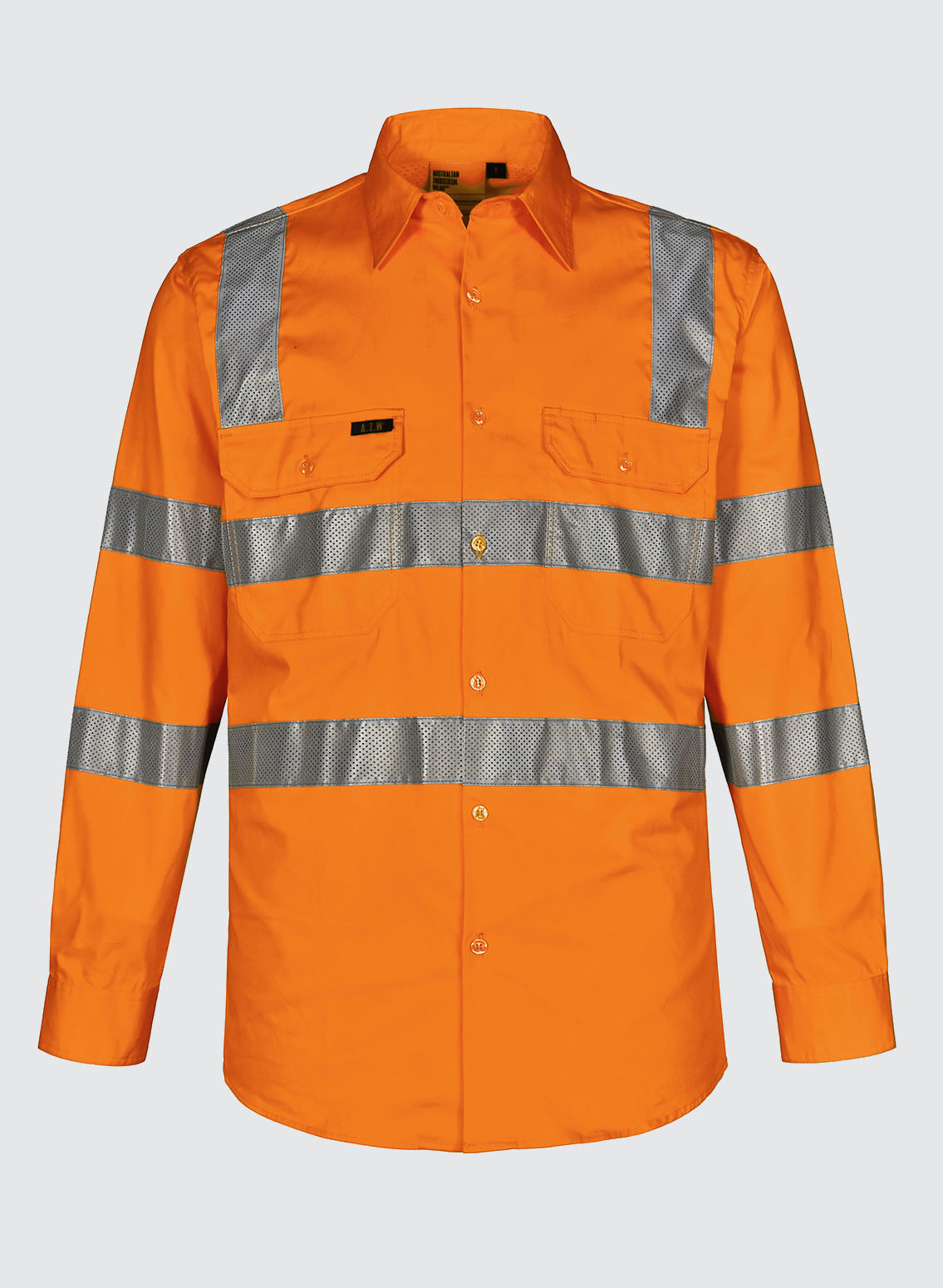All of Australia operates under stringent workplace health and safety laws designed to identify, assess and manage workplace safety risks and hazards. Increasing worker visibility is an integral part of this process, especially within the rail safety management sector.
The close proximity of rail workers to trains and other heavy machinery means that it’s imperative that rail workers are highly visible in all weather conditions and at all times of the day or night. Hi vis workwear has long been a logical aid in the effort to reduce the risk of accident and injury for rail industry workers because it provides instantly recognisable visibility and identification.
What Are The Australian Standards For Hi Vis Clothing?
It is important that both employees and employers know what is required to meet the Australian Government’s safety workwear requirements. There are several Australian Safety Standards that apply to the workwear industry and outline the requirements for specific types of work clothing, including for his vis, static electricity, waterproofing, sun protection, flame resistance and labelling. For Vic Rail his vis clothing the following Standards are the main ones encountered when selecting workwear.
- AS/NZS 4602.1:2011. This Standard specifies the structure of the garment, including its minimum design requirements such as coverage and positioning of reflective material. This Standard also defines three general classifications used to categorise hi vis garments; Class D (for outdoor use during the daytime only), Class N (night-time use only) and Class D/N (for use both during the day and night).
- AS/NZS 1906.4:2010 Part 4. This Standard specifies more on the colours allowed for high visibility safety garments while also covering the materials used in their manufacture.
- AS/NZS 4399:2017. This Standard provides information regarding the ability of the garment to provide protection from UV radiation – known as the Ultraviolet Protection Factor UPF. This one is particularly important for workers who are outside for long periods of time.
- AS/NZS 1020:1995. This Standard provides recommendations about the ability of the garment to reduce undesirable static electricity to assist in reducing the possibility of fires or explosions.
- AS/NZS 2622:1996, AS/NZS 2392:1999 and AS/NZS 1957:1998. These standards outline the methods for labelling the fibre content of products, methods for permanent labelling, and the care instructions needed to look after the garment properly.
- AS 2001.2.18-1987. This Standard outlines the water-repellent/water-resistant qualities of garment and breathability requirements.
Vic Rail Workwear Requirements
While railway workers fully appreciate the importance of hi vis gear and the extra visibility it provides, compliant garments are just the beginning. High-performing, high-quality workwear that is breathable and comfortable is the aim, along with a unified corporate identity. For Vic Rail, this has meant the development of their own Victoria State-specific hi vis rail wear.
If you are looking to purchase Vic Rail compliant clothing specifically, here is a summary of the conditions that must be met.

As defined by the Australian/NZ standards:
- Coverage. There must be at least 0.2 square metres of uninterrupted fluorescent material on the front and back of any hi-vis vest or another type of garment for daytime wear and 0.4 for nighttime.
- Reflective Tape (R Tape). Any reflective tape must be at least 50 mm wide and only placed in specified positions on the garment.
- Logos And Branding. Printing the business name or logo on hi vis workwear is permitted as long as it does not cover any of the reflective areas and still meets the ‘free space’ requirements of 0.2 square metres.
Vic Rail Specifics
- Colours. Vic Rail workers are required to wear hi vis ‘burnt’ orange. This is because this colour of orange contrasts better against the landscapes that are commonly seen around the rail network in Australia.
- Shoulder Stripes. Vic Rail complaint workwear requires 50mm reflective tape (R Tape) strips over both shoulders. These stripes do not meet.
- Waist Stripes. Two R Tape stripes are required around the upper waist of vests and tops. Front chest pockets are also a common feature in shirts, the R Tape will
- Arms. Arms must have 2 R Tape bands around each of them. Adding underarm venting squares up to 10cm x 10cm in size is also permitted.
- Trousers. Pants must be navy and also have two stripes of R Tape around the lower half of the legs.
It is worth noting that the placement of the stripes on the arms and legs is to aid in better referencing the body’s movements. This type of reflective wear is referred to as ‘Bio Motion’.

Top 3 Tips For Buying Vic Rail Hi Vis
Selecting the right safety clothing can sometimes be confusing, so we have put together these 3 top tips to help you choose the most suitable hi-vis clothing for rail workers.
- Double Check The Safety Standards. Always make sure what you are buying actually meets the required standards. Your supplier does not always know what your specific needs are; do not assume that they have checked that the garment is compliant.
- Stick To The Right Colours. It may sound simple, but there are a lot of variations on hi vis workwear out there, and for Vic Rail employees, burnt orange is the colour you need to provide maximum visibility.
- Comfort Is Key. People need to wear these garments all day. Making sure they are going to be comfortable is the best way to ensure the satisfaction and safety of the wearer. Look for breathability, fabric care and capabilities, along with making sure they are fit for purpose. If you’re too hot or get wet, you may find you’re not paying attention – this is when accidents occur.
How Often Should Hi Vis Workwear Be Replaced?
Typically hi-vis garments that are worn regularly should be replaced every 3-6 months. In addition, regular inspections are recommended to check for any signs your hi-vis workwear may have faded, deteriorated, been soiled or damaged, meaning it may no longer meet the requirements of the Australian Safety Standards.
Branding Hi-Visibility Workwear
Adding your logo or business name to your workwear carries the additional bonus of providing a professional image while extending brand representation companywide. However, when it comes to hi vis workwear, care must be taken in order to avoid jeopardising the ability of the garment to meet the requirements of the Australian Safety Standards.
For example; Day compliance hi vis workwear must meet the 0.2 m2 coverage on both the front and back of the garment. As a general rule, a log the size of 10cm x 10cm will allow the garment to remain within the boundaries of compliance.
3 Techniques Suitable For Branding Hi Vis Workwear
1. Embroidery
Embroidery provides an accurate, flexible, durable and hard-wearing option, and they are one of the most popular choices for his vis workwear. Embroidered logos can be positioned in a number of locations. Embroidery can be used on hi-vis polos, hi-vis shirts, vests and overalls, pants, shorts, hi-vis jackets, hoodies and polar fleece jumpers, as well as hats, caps and beanies. It is important to note, however, embroidery may not be suitable when seeking to maintain the water-resistant properties of the garment.
2. Screen Printing
Screen printing is a popular alternative to embroidery that offers an economical solution to branding some garments. Screen printing is best suited to fabrics that allow the ink to permeate the material and isn’t always suitable for all hi-vis fabrics, particularly if the fabric has been treated with waterproof coatings.
3. Custom Tags
A subtle way of adding branding to clothing, printing custom tags is best done at the point of manufacture; however, they must still meet the requirements of the Safety Standards mentioned above. This can be a good strategy for hi vis clothing when you don’t want to clutter up its fluorescent and reflective areas.
With years of experience in providing quality workwear and uniforms, BIG Branding understands what it takes to keep rail workers safe on the job. We’re proud to provide a range of affordable rail workwear that can help increase your visibility while ensuring compliance with all the relevant safety regulations. Our assortment of rail compliant workwear for VIC Rail includes long sleeve shirts, polar fleeces, jackets, and vests, all featuring the distinctive reflective strips in the VIC Rail configurations. Shop online to see our range or contact the team today for a quote or to answer any questions you may have.





